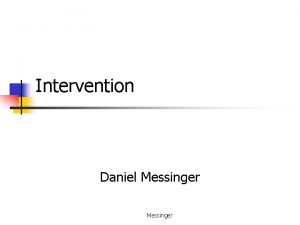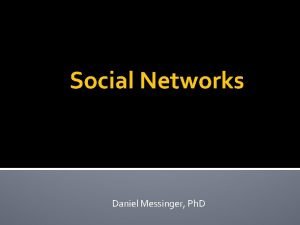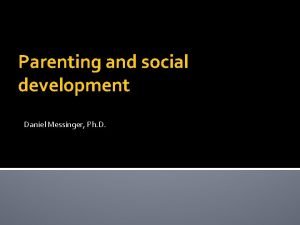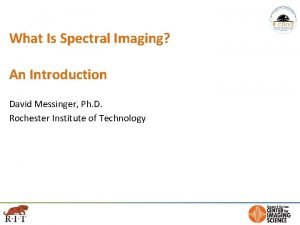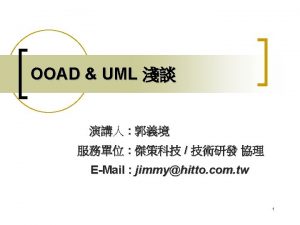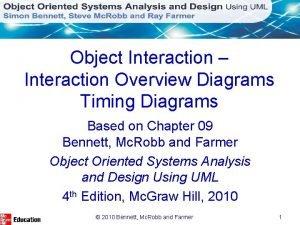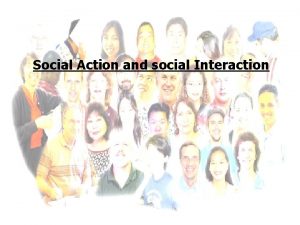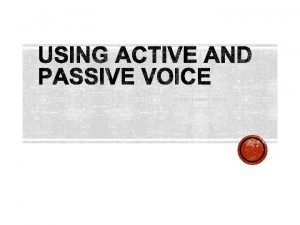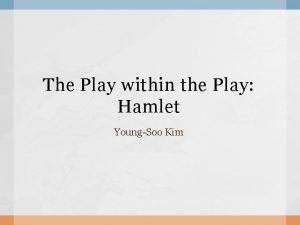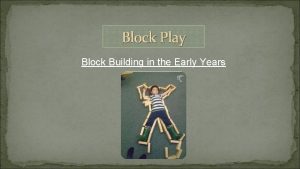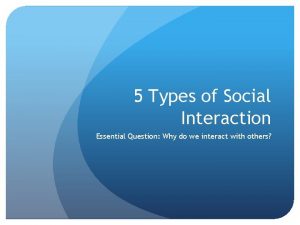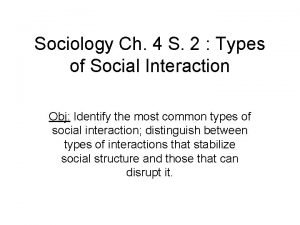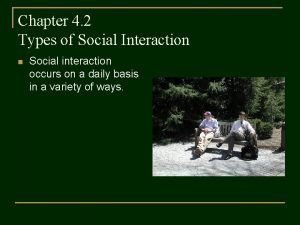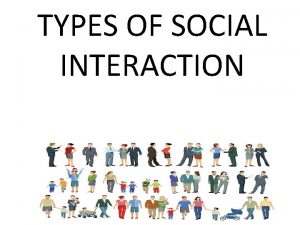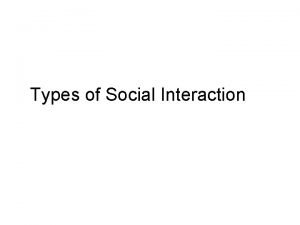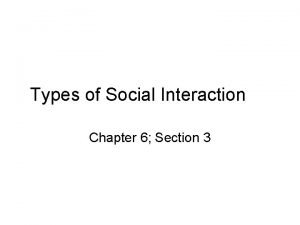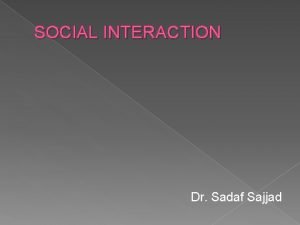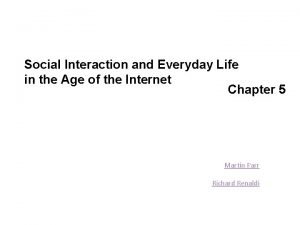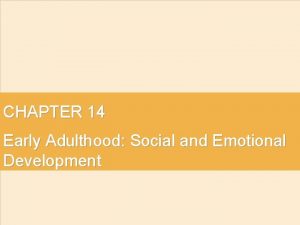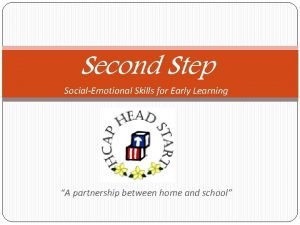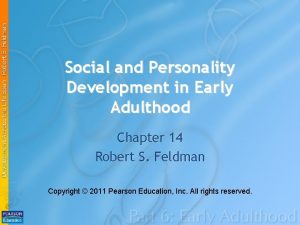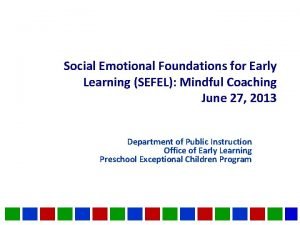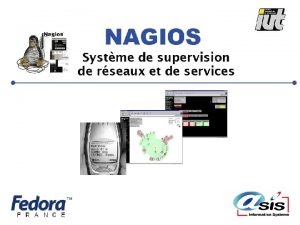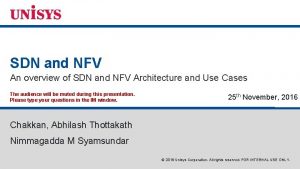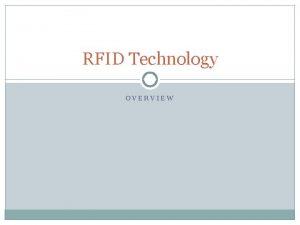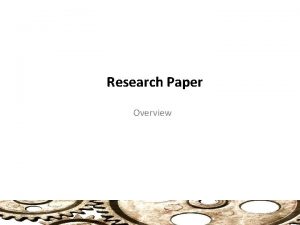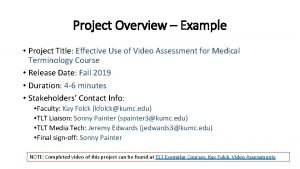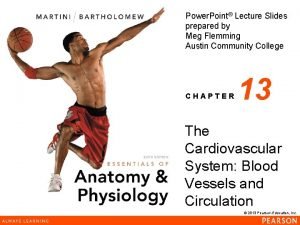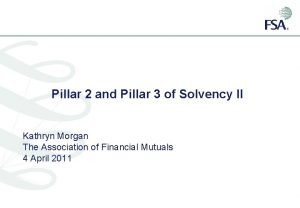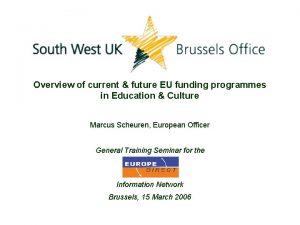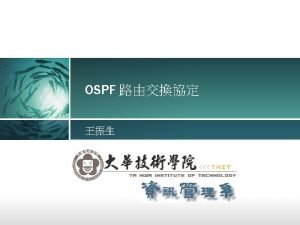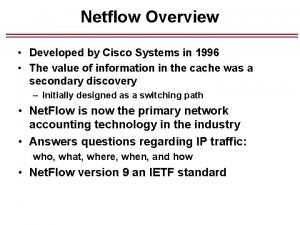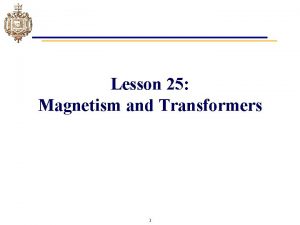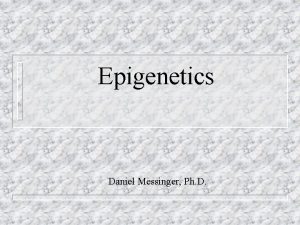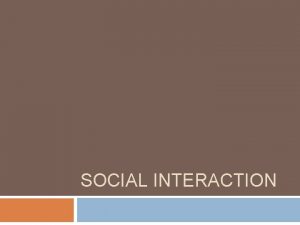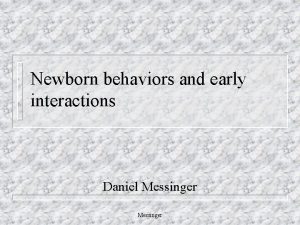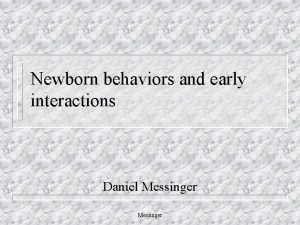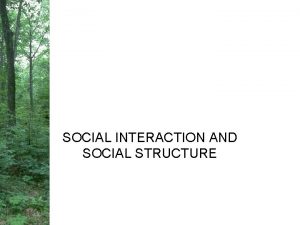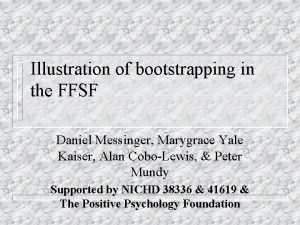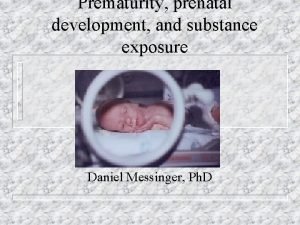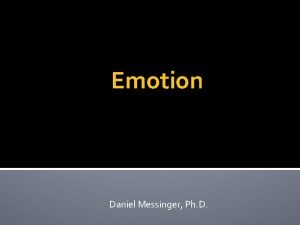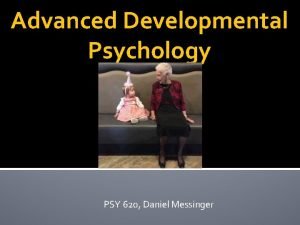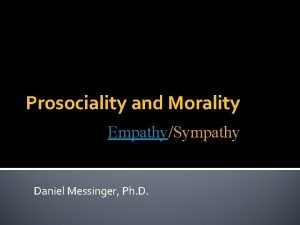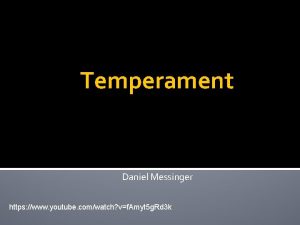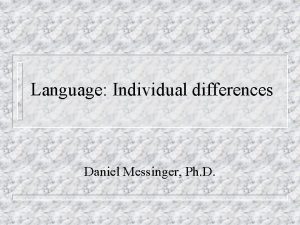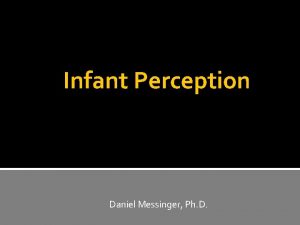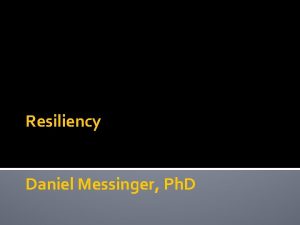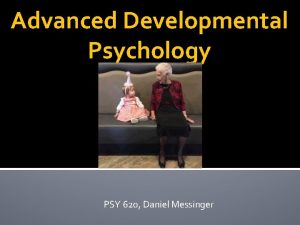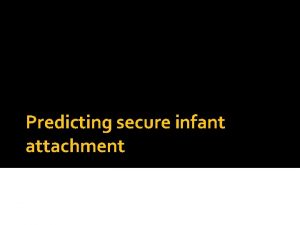Early Interaction Daniel Messinger Early social play overview




















































































- Slides: 84

Early Interaction Daniel Messinger

Early social play overview n n Developmental and cultural context Murray’s maternal mirroring & marking – n Bi-directional but…. – n n Smile turn-taking over time Mom and baby have different goals? Systems: self/interactive contingency associated Early care overview, institutionalization, and brain development 2

Play & SF Overview n n n Early care overview, institutionalization, and brain development Systems: self/interactive contingency associated Who leads whom SF and Dynamic still-face OT Your projects 3

Results 4

Institutionalization and brain development White matter more plastic? § Typically developing children Romania (NIG) § institutionalized rearing (CAUG) § previous institutional rearing then randomized to high-quality foster care intervention (FCG)

Early caregiving relationships Social, emotional, cognitive, biological outcomes, and… Brain Development?

Maternal positive affect (5 m 10 & 24 m infant frontal power (EEG activity)

Social play n Enjoyable interaction for its own sake – "mutual maintenance of attention and arousal within” a range that facilitates positive expressions like smiles and coos • n (Stern, 1974 a, p. 404). Often occurs during face-to-face interactions in the middle-class West 17

Early interaction n Mother tends to gaze at infant almost continuously Through two months, infants are transfixed by caregiver’s face Infant and caregiver interactions resemble those of romantic lovers in the beginning of the relationship 18

Smile development in Germany and Africa n n ‘At 6 weeks, mothers and infants from both communities smiled at each other for similar (albeit very short) amounts of time and imitated each other’s smiling rarely. At 12 weeks, mothers and their infants from Münster smiled at and imitated each other more often than did Nso mothers and their infants. • Wörmann, V. , Holodynski, M. , Kärtner, J. , & Keller, H. (2012). A cross-cultural comparison of the development of the social smile: A longitudinal study of maternal and infant imitation in 6 - and 12 -week-old infants. Infant Behavior and Development, 35(3), 335 -347. doi: 10. 1016/j. infbeh. 2012. 03. 002 19

20

Percent of session Infant gaze at mother declines – except when mother is smiling Why? Inexact depiction of Kaye & Fogel, 1978 21

Infant Smile, Mother Smile psy. miami. edu/faculty/dmessinger/

Pattern in middle-class western dyads n n Infant gazes at the mother who smiles, makes an exaggerated display, and/or vocalizes. The infant smiles. The mother smiles or is already smiling. The infant gazes away. The mother tones things down and waits or tries to get the infant's attention. Clinical implications 26

THE FUNCTIONAL ARCHITECTURE OF MOTHERINFANT COMMUNICATION, AND THE DEVELOPMENT OF INFANT SOCIAL EXPRESSIVENESS IN THE FIRST TWO MONTHS Murray et al. , 2016 Vulovic

PARENTAL BEHAVIOR AND INFANT SOCIAL EXPRESSIVENESS • Contingency of parent’s responsiveness • Functional Architecture • emphasizes the experience-expectant nature of early social engagement Vulovic

THE STUDY • 20 healthy mother-infant dyads • In-home visits at 1, 3, 5, 7 and 9 weeks postpartum • Infant events • Positive Social Expressions • Biological Events • Negative Affect • Non-Social Mouth Movement • Maternal events • Contingent • Non-Contingent Vulovic

Vulovic

MATERNAL BEHAVIOR Vulovic

Figure 3 Figure 4 Vulovic

FINDINGS • Frequency did not reinforce the infant behaviors • Form of maternal response was important • Preferential behaviors = marking with a smile and mirroring Vulovic

• Would the findings be different if the mothers were instead told to interact positively with their infants? DISCUSSIO N • Do you think we would’ve seen different outcomes if there were more female infants? • The mirror! Vulovic

Social-emotional development Smile turn-taking increased with age, mean r = 0. 43, p < 0. 001 Turn-taking No Turn-taking Mother Smile Infant Smile psy. miami. edu/faculty/dmessinger Mother Smile

Face-to-face interaction can be bi -directional n Infants tend to influence parents who sometimes influence infants n – Influencing the probability the partner will engage in a particular action n – Mothers are not simply inserting their actions in the pauses between infant actions Not determining that the action will occur. Developmentally, infants become more likely to reciprocate and to elicit 39

Mutual regulation (=bi-directional) • “both partners reciprocally modify their actions based on feedback they receive from their partners” (Tronick et al. , 1978, p. 2). • This is how infants learn “the meaning of their own expressive behavior” (Tronick et al. , 1978, p. 1). – video 40


Self-contingency & interactive contingency Reciprocal associations between self and interactive contingency in mother-infant interaction for facial affect, vocal affect, facial-visual engagement, and orientation.

Inverse Optimal Control Mathematical framework linking observed behavior during early social interaction with infant and mother reward structure Sensory Feedback and Reward Action World (mother smiling)

Im pl ic at io ns fo ra ut ism ? What do babies want? Not what moms want….

Infant leads parent Chow, Haltigan, & Messinger, 2010, Emotion Face-to-Face Still-Face Reunion

Interactive Influence Emotional influence itself varies with time during interactive episodes Face-to-Face Still-Face Reunion

Face-to-face n n The coordination of affective expression during face -to-face interactions facilitates the transition from mutual regulation to self-regulation. Face-to-face synchrony infants’ first opportunity – – – practice interpersonal coordination of biological rhythms, experience the mutual regulation of positive arousal, build the lead-lag structure of adult communication.

What does face-to-face teach? n My partner is responsive to me I feel things with my partner I take turns with my partner n Depends on action modality n n – – Smiles become shared Vocalizations not 57

Evidence of infant expectations/intentionality n How do we know if infant really is attempting to get interaction back on track? – – Cease interaction See if infant attempts to re-commence interaction 58

Face to Face-Still Face (video) Face to Face (FF) 3 minutes Still Face (SF) 2 minutes Reunion (RE) 3 minutes

Idealized still-face description n Infant orients and greets mother – n But then looks away – – n n Gazes at mother and smiles Gazes at mother, even “smiles briefly, yet warily in less and less convinced attempts to get the interaction back on track” (p. 8), Eventually withdrawing, with body and gaze oriented away, giving up. Tronick FFSF at 15 s Reality: Individual differences in expression of positive and negative affect http: //www. youtube. com/watch? v=apz. XGEb. Zht 0 61

The many faces of the Still. Face Paradigm: A review and meta-analysis by Mesman, van IJzendoorn, & Bakermans-Kranenburg

SFP Effects

THE DYNAMIC STILL-FACE EFFECT: DO INFANTS DECREASE BIDDING OVER TIME WHEN PARENTS ARE NOT RESPONSIVE? EKAS ET AL. , (2012) Zeng

INFANTS’ RESPONSES TO DISRUPTED INTERACTIONS • Infants are active regulators in social interactions! • Predictors of later attachment security, emotion regulation, and behavioral problems Lacked Smiles More Externalizing Fewer Cries Less Internalizing Eliciting Behavior Positive Affect https: //www. youtube. com/watch? v=apz. XGEb. Zht 0 (1: 06) Security Attachment Zeng

TEMPORAL DYNAMICS OF INFANT BEHAVIORS Infant negative affect Mother 0 Infant social bidding Time Zeng

CURRENT STUDY 44 parent-infant dyads 33 with siblings with ASD and 21 without siblings with ASD 6 Month • • Zeng FFSF Gazes at/away Smiles/Cries Positive social bids 15 months • • SSP Secure Avoidant Resistant 18 months • CBCL

MEAN LEVEL ACROSS EPISODES Zeng

TEMPORAL DYNAMICS DURING SF Zeng

ASSOCIATION WITH LATER ADAPTATION Not Significant Zeng

ASSOCIATION WITH LATER ADAPTATION Cry – Internalizing (r = -. 52) Internalizing Problems

FINDINGS Decreased social bids, social attention, and smiles during interrupted interactions Increased negative affect during interrupted interactions Decrease in gaze Attachment (avoidant > secure > resistant) Increase in cries Internalizing problems Zeng

DISCUSSIONS How would you explain the null findings for associations between positive social bids/smiles and attachment? Why resistant infants with slowest decrease of gaze? How would you explain the association between cry and internalizing problems? Why disorganized infants have mothers who cannot keep a still face? Zeng

Interaction outcomes n n Review Ekas Watch FFSF attachment; Mesman Prince et al: Is there an association Kochanska/Feldman—what’s the association? – n FFSF ? Empathy/cooperation Oxytocin is a (longitudinal) mediator – Projects? 74

DYNAMIC STILL-FACE EFFECT PSY. MIAMI. EDU/FACULTY/DMESSINGER/ Ekas, et al. , 2012

Overall strategy n A – Avoidant – n B – Secure – n Seek and be comforted by caregiver C – Resistant – n Avoid caregiver Seek caregiving without surcease D – Disorganized – Lack a coherent strategy 77

n aniz isorg n A: Insecurely attached, AVOIDANT type B: Securely attached C: Insecurely attached, RESISTANT type D: D n ed Attachment Security: Important index of socioemotional development 78

Still-face Security…

Testing the Mid-Range Model: Attachment in a High Risk Sample Prince et al. , 2020 Futterer

The Mid-Range Model & Attachment ○ Sensitive responsivity == contingent X responsivity ○ High and low maternal contingent responsivity insecure attachment or disorganization ○ What about infant responsivity? Futterer 81

The Current Study ○ Curvilinear associations between responsivity and attachment ○ Maternal Lifestyle Study Sample ● ● ● 625 dyads FFSF @ 4 months SSP @ 18 months Drug risk score Social risk score Futterer 82

Results Futterer 83

Results Futterer 84

Results Futterer 85

Discussion ○ Why do you think infant responsivity was not associated with attachment outcomes? ○ Infants with high or low responsivity mothers [at 4 months] were more likely to have disorganized attachment outcomes at 18 months…were they really that much more likely? ● ○ Majority was < 20% likelihood – what can we make of that? Mesman et al. , (2009). found infant affective engagement during the maternal still face was associated with attachment classification, but Prince et al. , (2020) did not. Authors rationalized this was the case because of differing demographic factors; therefore, is it fair to use the same attachment classifications for non-White groups when adaptive caregiving practices may vary by group? Why or why not? Futterer 86

Overview ○ More research is needed on face-to-face interactions and attachment classifications for non-White groups ○ Mid-range levels of maternal responsivity may promote organized attachment and later resiliency ● Important to continue to identify the adaptive (and maladaptive) behaviors that contribute to attachment security (or insecurity) Futterer 87

Mutual Influence Infant Mother and Mother Infant Relation to bi-directional influence, synchrony… Through mutual influence, infants come to understand themselves as social beings who affect and are affected by others 88

A close look at interaction psy. miami. edu/faculty/dmessinger/

Face-to-face/still-face

Mutual Responsive Orientation “a positive, close, mutually binding, and cooperative relationship, which encompasses two components: responsiveness and shared positive affect” Kochanska 91

n How does MRO work? n Positive mood yields prosocial behavior Promotes responsive stance toward parent And committed compliance n n – – Eagerly working with parent Potential pathway to internalization

Proposed mechanism Young infants who act with the developing expectation of eliciting positive affect in the parent develop to be young children who regulate themselves to please their parents. n 94

Parent-Infant Interaction Infant Smile, Mother Smile psy. miami. edu/faculty/dmessinger

96

Face-to-face n The predilection of mothers to shift affective states to match those of their infants is related to increases in infants selfcontrol and cognitive performance at two years (Feldman et al. , 1999) 97

3/9 months to 2 years Feldman et al 1999 99

Adolescent’s capacity to engage in an empathetic exchange n n Child self-regulated compliance across the toddler and preschool years mediated the relations between the lead-lag structure of early interactions and the adolescent's dialogical skills. Direct associations were found between mother-infant synchrony and the capacity for empathy in adolescence. • (Feldman, 07)

Children’s Conscience and Self. Regulation (Kochanska & Aksan, 2006) n n Conscience: an inner self-regulatory system Results from 3 large longitudinal studies Temperament Moral Emotions Predictors of Conscience Socialization Moral Conduct

Predictors of Conscience n Temperament – Fearfulness n – Effortful control n n Underpinning of children’s guilt Underpinning of children’s emerging ability to regulate their conduct Socialization of the family – – Reciprocal, positive interactions necessary Mutually responsive orientation (MRO) n n – Parent/child cooperativeness & responsiveness Shared dyadic positive affect Parental warm discipline v. parental power assertion Kolnik

Overall Finding n “Children growing up with parents who are responsive to their needs and whose interactions are infused with happy emotions adopt a willing, responsive stance toward parental influence and become eager to embrace parental values and standards for behavior. ” – Kochanska, 2002 105

Sensitive Structuring www. psy. miami. edu/faculty/dmessinger

Sensitive Structuring Expressive Language Growth Baker, et al. , 2010 For toddlers who received an ASD diagnosis www. psy. miami. edu/faculty/dmessinger

Oxytocin enables pup retrieval www. nature. com/natur e/journal/vaop/ncurrent /full/nature 14402. html BJ Marlin et al. Nature 000, 1 -6 (2015) doi: 10. 1038/natur e 14402

PRIORITY COMMUNICATION: Oxytocin administration to parent enhances infant physiological and behavioral readiness for social engagement 2016 O. Weisman, O. Zagoory-Sharon, & R. Feldman From the Department of Psychology & the Gonda Brain Sciences Center, Bar-Ilan University, Ramat-Gan, Israel

Overview Lingering Questions Aims Design Data Theresa Can exogenously administered OT increase parent social engagement with their infant? • If parent social engagement changes, is there parallel change observed in the infant? Evaluate difference in social affiliation across OT and placebo for infant and father measuring three domains: • Hormone levels • Autonomic regulation • Social affiliation behaviors Administered intranasal OT or placebo to father • Condition order counterbalanced and doubleblind Collected for within-subjects comparison in infants and fathers using measures collected during: • Pre-interaction • Face-to-Face Still-Face interaction • Post-interaction

Results of OT Shaffer & Theresa

RSA Results Shaffer & Theresa

Results of Social Behavior Pos affe itive exp ctive ress ion ? Shaffer

‘Commercially available EIA assays without extraction two orders of magnitude higher than conventional RIA methods with extraction’ http: //www. psy. miami. edu/faculty/mmccullough/Papers/Mc. Cullough-Churchland-Mendez-Final. pdf
 Linda ray intervention center
Linda ray intervention center Sciclogy
Sciclogy Daniel messinger
Daniel messinger Daniel messinger
Daniel messinger David messinger rit
David messinger rit Bruce messinger
Bruce messinger Uml 0..*
Uml 0..* Real-time interaction management
Real-time interaction management Design pattern uml
Design pattern uml Interaction overview diagram
Interaction overview diagram Social action vs social interaction
Social action vs social interaction Early years learning framework overview
Early years learning framework overview I've got a friend we like to play we play together
I've got a friend we like to play we play together Play random play basketball
Play random play basketball Play by play
Play by play Gozago
Gozago Social thinking and social influence in psychology
Social thinking and social influence in psychology Social thinking social influence social relations
Social thinking social influence social relations Block play early years
Block play early years It refers to the life long process of social interaction.
It refers to the life long process of social interaction. Social interaction in everyday life
Social interaction in everyday life Communication patterns in groups
Communication patterns in groups 5 types of social interaction
5 types of social interaction Sources of language history
Sources of language history What is sociology
What is sociology Is the lifelong process of social interaction
Is the lifelong process of social interaction 4 interaction types
4 interaction types Social interaction cooperation
Social interaction cooperation Examples of social interaction in everyday life
Examples of social interaction in everyday life Cooperation social interaction
Cooperation social interaction What is social interaction
What is social interaction Importance of social interaction
Importance of social interaction Interactional vandalism definition
Interactional vandalism definition What is social interaction
What is social interaction Early cpr and early defibrillation can: *
Early cpr and early defibrillation can: * Middle age physical changes
Middle age physical changes Social development in early adulthood
Social development in early adulthood Second step social emotional skills for early learning
Second step social emotional skills for early learning Social and personality development in early adulthood
Social and personality development in early adulthood Social impact statement for early design review
Social impact statement for early design review Social and emotional foundations for early learning
Social and emotional foundations for early learning Why did aristocrats like the philosophy of legalism?
Why did aristocrats like the philosophy of legalism? Social impact statement for early design review
Social impact statement for early design review Overview of www
Overview of www Maximo overview
Maximo overview Uml overview
Uml overview In uml is a connection among things
In uml is a connection among things Retail vertical
Retail vertical Figure 12-1 provides an overview of the lymphatic vessels
Figure 12-1 provides an overview of the lymphatic vessels Major veins of the body
Major veins of the body Texas public school finance overview
Texas public school finance overview Walmart inventory management systems
Walmart inventory management systems Stylistic overview of painting
Stylistic overview of painting What is sa/sd methodology?
What is sa/sd methodology? Spring framework overview
Spring framework overview Nagios tactical overview
Nagios tactical overview Market overview managed file transfer solutions
Market overview managed file transfer solutions Nfv vs sdn
Nfv vs sdn Sbic program overview
Sbic program overview Sap consignment process
Sap consignment process Ariba overview
Ariba overview Safe overview
Safe overview Rfid technology overview
Rfid technology overview Overview in research example
Overview in research example Overview of transcription and translation
Overview of transcription and translation Example of a project overview
Example of a project overview Venous drainage of the abdomen
Venous drainage of the abdomen Abstract vs summary
Abstract vs summary Solvency ii pillar 2
Solvency ii pillar 2 Overview of physical storage media
Overview of physical storage media Example of nursing process
Example of nursing process Overview funding programmes
Overview funding programmes Ospf overview
Ospf overview Architecture review template
Architecture review template Oedipus rex scene 3 summary
Oedipus rex scene 3 summary Show ip cache flow
Show ip cache flow Overview of the national tuberculosis elimination program
Overview of the national tuberculosis elimination program Mpls header format
Mpls header format Bill zack
Bill zack Master data services overview
Master data services overview Overview of cellular respiration
Overview of cellular respiration Overview of respiration
Overview of respiration Overview of cellular respiration
Overview of cellular respiration Overview of cellular respiration
Overview of cellular respiration Transformer overview
Transformer overview
